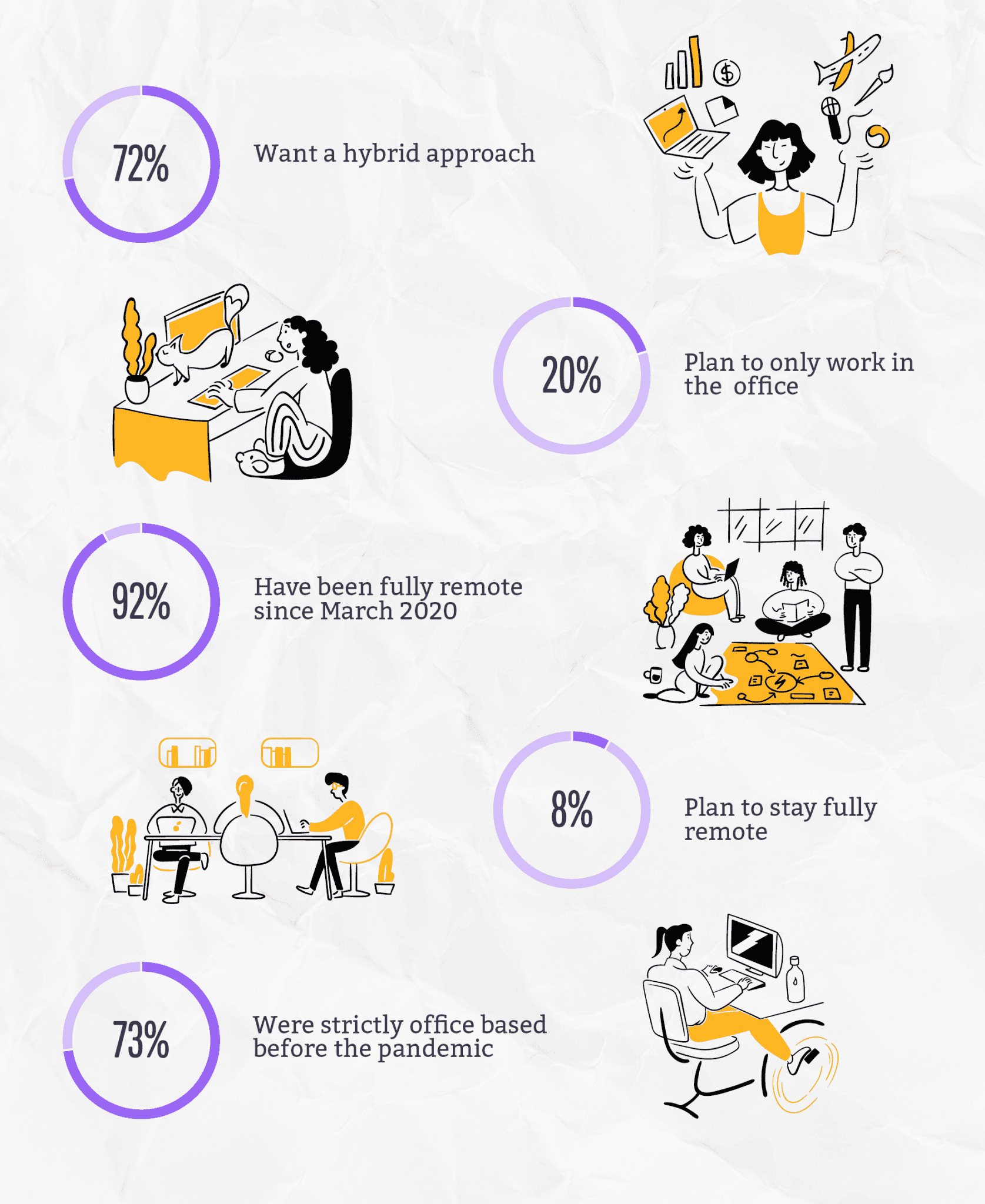How To Build a Future-Proof Hybrid Employee Experience

Barry Nyhan
Senior Demand Gen & Marketing Ops
30 Mar 2021

In 2020 the world of work changed forever, and ever since we’ve all been struggling with how we can make remote work work.
Every day, businesses face new challenges with remote working. From onboarding remote employees and trying to create a positive culture from home, to communication issues.

It’s not just companies feeling the struggles of remote work either. Employees feel like they’re running uphill with work-life balance, finding it hard to switch off. (Not being able to unplug is the #1 struggle for people working remotely according to Buffer’s 2021 State of Remote Work Report)
Because of that, there’s now a race to fix remote work as we prepare for a hybrid future.
So we ran a big survey to HR leaders that range from 300 to 80,000 in company size to discover how we can create a better employee experience and learn from each other.
In this article, we’re going to break down the survey results where we asked HR leaders to share how they and their companies reacted to the pandemic, their key challenges, and what measures their companies are taking to adjust to the new normal.
Read on if helping your employees stay informed, engaged, and connected wherever they work from is a priority for you right now.
How Businesses Reacted To The Pandemic
The pandemic pushed companies off the edge of a cliff quite quickly in terms of adapting to the crisis. In a recent survey that we conducted, we asked people about their work situation before and after the pandemic, as well as going forward.

It looks like office centricity is over and a hybrid working future is here to stay. With 72% of people we surveyed wanting to split their time between their home-office and their office-office, what has to change to make it work?
We’ll get to the point…HR leaders will have to meet certain needs of employees that while were important beforehand, are now everyone’s #1 priority and challenge. Otherwise, hybrid work will crash and burn.
That means creating a sense of belonging, culture, meaningful bonds, and connection without the daily trip to the physical office. Easier said than done, but these are the core things that create the level of fatigue, anxiety, and disengagement and everybody keeps complaining about when they’re not met.
Can you see the pattern?
Everything mentioned so far is simply a dimension of communication. The next evolution of internal comms needs to be built around asynchronous, meaningful connections that create communities and help people work more closely together, digitally.

What HR leaders should do to make hybrid work work
From our survey, we saw that huge numbers of people have been more stressed out since the pandemic began. 92% of them to be exact.
Not only that, but 1 in 2 people feel more disengaged from their organizations since last March.
It’s fair to say these stats paint an unhappy picture. So, it’s normal for HR leaders to have concerns around the fact that hybrid work is here to stay. Especially since the recent shift has caused a storm of challenges to impact everyone, from CEOs to new hires right out of university.
These challenges include:
- A less connected team
- Employee satisfaction & well-being declining
- Disengaged employees
In saying that, every problem has a solution, right? So how can people leaders build a future-proof hybrid workplace employee experience?
- Create a sense of connection and belonging – This is the new “holy grail” when it comes to employee experience
- Foster an open culture of sharing and recognition that helps employees feel a part of something bigger than themselves
- Break communication barriers, boldly become flat, transparent, and give everyone a voice. This is the only way to truly create engagement
If it feels like your team is slipping away – check out how People leaders use Workvivo to keep their employees happy and engaged in one place.

So what’s the key to making hybrid work in the long run?
In our survey, people leaders told us they want a more humanized employee experience; more recognition, collaboration, and more communication for their employees.
Employees aren’t missing the ping pong tables, the bean bags, or the office ‘perks’. What they are missing is being told publicly ‘Hey, great job!’ and ‘Happy Birthday’. The key to employee’s belonging in an organization is communication and creating emotional commitment.
Before we go any further, we need to address the elephant in the room. People flocked to one of Slack, Teams, or Zoom as their digital office replacement. In fact, 2 of 3 companies that purchased and rolled out a new comms tool since the pandemic chose one of these tools.
But was that the right choice?
2 in 3 people that took part in our great big employee experience survey shared that they feel overwhelmed with instant messaging.

To echo this sentiment even more, renowned author, Cal Newport exposes the scale of our instant messaging problem in his New Yorker article. He highlights the software firm RescueTime estimate that employees who use Slack, access the platform once every five minutes on average—which is an incredibly high rate of interruption.
Humans were not designed for 5-minute context switching.
Now don’t get us wrong. It’s not that tools like Slack / Teams don’t work. They’re great for bringing productivity and operational alignment into an org (and most companies have this transactional comms gap fixed at this stage). But what they’re not designed to bring is cultural alignment – which is critical to employee satisfaction, engagement, and retention.
The key to making this exciting new world of hybrid work in the long run is by focusing on the stuff that’s hard to replicate outside the office but is so necessary to keep teams happy, engaged, and motivated.
It’s the humanity-driven aspects of work that many have been missing such as that sense of connection and belonging in a company, that feeling of having an impact on ‘something bigger’ than ourselves, that connection to company culture, values, and vision.
The alternatives that bring these to the table will need to be more mindful and prioritize clarity, without the overwhelming noise many have experienced in the last 12 months. They should focus on asynchronous communication and encourage employees to participate and engage in their own pace, and style.

According to the Workvivo CEO, John Goulding, “we can learn a lot from what’s working in the asynchronous world”.
Utilizing tools such as podcasts and videos allows HR leaders to connect with their employees on a deeper level. It enables them to talk directly to the employee, without having to contact each one individually. Employees can feel that deeper connection and process the information in their own time.
Having one central hub that becomes the beating heart of your digital workplace where employees can digest information and announcements at their own pace will naturally engage employees.
People are now realizing asynchronous communications was the big missing piece in the digital-first, office-less workplace nobody could put their finger on for a long time. But it’s now moved out of the shadow of instant messaging and now the demand for asynchronous comms is on the rise.
Why not try our asynchronous first employee communication platform?

